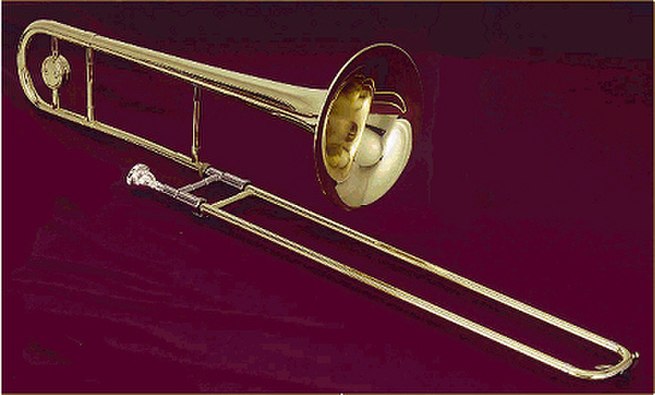
Main Difference
The main difference between Trombone and Sackbut is that the Trombone is a type of brass instrument and Sackbut is a trombone from the Renaissance and Baroque eras.
-
Trombone
The trombone is a musical instrument in the brass family. As on all brass instruments, sound is produced when the player’s vibrating lips (embouchure) cause the air column inside the instrument to vibrate. Nearly all trombones have a telescoping slide mechanism that varies the length of the instrument to change the pitch. Many modern trombone models also use a valve attachment to lower the pitch of the instrument. Variants such as the valve trombone and superbone have three valves similar to those on the trumpet.
The word “trombone” derives from Italian tromba (trumpet) and -one (a suffix meaning “large”), so the name means “large trumpet”. The trombone has a predominantly cylindrical bore like its valved counterpart the baritone and in contrast to its conical valved counterparts, the cornet, the euphonium, and the French horn. The most frequently encountered trombones are the tenor trombone and bass trombone. The most common variant, the tenor, is a non-transposing instrument pitched in B♭, an octave below the B♭ trumpet and an octave above the pedal B♭ tuba. The once common E♭ alto trombone became less widely used as improvements in technique extended the upper range of the tenor, but it is now enjoying a resurgence due to its lighter sonority which is appreciated in many classical and early romantic works. Trombone music is usually written in concert pitch in either bass or tenor clef, although exceptions do occur, notably in British brass-band music where the tenor trombone is presented as a B♭ transposing instrument, written in treble clef.
A person who plays the trombone is called a trombonist or trombone player.
-
Sackbut
A sackbut is a type of trombone from the Renaissance and Baroque eras, characterised by a telescopic slide that is used to vary the length of the tube to change pitch. Unlike the earlier slide trumpet from which it evolved, the sackbut possesses a U-shaped slide, with two parallel sliding tubes, which allows for playing scales in a lower range.
Records of the term “trombone” predates the term “sackbut” by two decades, and evidence for the German term “Posaune” is even older. “Sackbut”, originally a French term, was used in England until the instrument fell into disuse in the eighteenth century; when it returned, the Italian term “trombone” became dominant. In modern English, an older trombone or its replica is called a sackbut.
An older instrument generally differs from modern trombones by its smaller, more cylindrically-proportioned bore, and its less-flared bell. The bell section was more resonant (since it did not contain the tuning slide and was loosely stayed rather than firmly braced to itself). These traits produce a “covered, blended sound which was a timbre particularly effective for working with voices,… zincks and crumhorns”, as in an alta capella.
The revived instrument had changed in specific ways. In the mid-18th century, the bell flare increased, crooks fell out of use, and flat, removable stays were replaced by tubular braces. The new shape produced a stronger sound, suitable to open-air performance in the marching bands where trombones became popular again in the 19th century. Before the early 19th century, most trombones adjusted tuning with a crook on the joint between the bell and slide or, more rarely, between the mouthpiece and the slide, rather than the modern tuning slide on the bell curve, whose cylindrical sections prevent the instrument from flaring smoothly through this section. Older trombones also generally don’t have water keys, stockings, a leadpipe, or a slide lock, but as these parts are not critical to sound, replicas may include them. Bore size remained variable, as it still is today.
-
Trombone (noun)
A musical instrument in the brass family, having a cylindrical bore, and usually a sliding tube (but sometimes piston valves, and rarely both). Most often refers to the tenor trombone, which is the most common type of trombone and has a fundamental tone of B♭ˌ (contra B♭).
“Jim plays the trombone very well.”
“This trombone is very expensive.”
-
Trombone (noun)
The common European bittern.
-
Trombone (verb)
To transmit a signal or data back to a central switching point before sending it out to its destination.
-
Sackbut (noun)
A Renaissance and Baroque Eras, and an ancestor of the modern trombone. It was derived from the medieval slide trumpet.
-
Trombone (noun)
a large brass wind instrument with straight tubing in three sections, ending in a bell over the player’s left shoulder, different fundamental notes being made using a forward-pointing extendable slide.
-
Trombone (noun)
an organ stop with the quality of a trombone.
